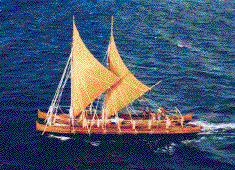 The Building of the Hawai`iloa
The Building of the Hawai`iloa The Voyaging Canoe, Hawai`iloa
The Voyaging Canoe, Hawai`iloa


 The Building of the Hawai`iloa
The Building of the Hawai`iloa
The Voyage to Nukuhiva
Scholars believe that early voyages of settlement to Hawai'i, over 1600 years ago, came from the Marquesas Islands. The argument for a Marquesan origin of some of the early settlers is based in part on linguistic and biological evidence. Archaeologist Patrick Kirch writes, "Indeed, the close relationship between the Hawaiian and Marquesan languages as well as between the physical populations constitutes strong and mutually corroborative evidence that the early Hawaiians came from the Marquesas" (Feather Gods and Fishhooks 64).
Adzes, fishhooks, and pendants found at an early settlement site at Ka Lae on the Big Island of Hawai'i resemble those found in the Marquesas, Also, the Marquesas Islands are the best departure point for sailing to Hawai'i from the South Pacific because they are closer and farther east (upwind) than the Society Islands or the Cook Islands, two other possible sources of early migrants.
From 1990-1995, in order to help recover Hawaiian voyaging arts, PVS was contracted to build a replica of traditional double-hulled voyaging canoe. This canoe was named Hawai'iloa. In the spring of 1995, PVS will sail Hawai'iloa along with the older voyaging canoe Hokule'a to Tahiti and Nukuhiva (Marquesas Islands) and back to Hawai`i. Linguistic and archaeological evidence suggests that early Polynesian settlers to Hawai`i came from those islands. The closest language to Hawaiian is a Marquesan dialect spoken in the southern Isles of Hiva.
The 1995 voyage will retrace this early migration route to Hawai`i from the Marquesas in order to recover voyaging values, traditions and practices. Daily reports from the canoes will be posted on this information service.